Leak-off test geomechanics PDF

| Title | Leak-off test geomechanics |
|---|---|
| Author | Sherill De la Cruz |
| Course | Mecánica |
| Institution | Bachillerato (México) |
| Pages | 13 |
| File Size | 1.3 MB |
| File Type | |
| Total Downloads | 88 |
| Total Views | 142 |
Summary
SOLUCIONARIO
...
Description
ARMA/NARMS 04-547
Leak-Off Test Interpretation and Modeling with Application to Geomechanics Donald Lee Schlumberger Data Consulting Service, Houston, Texas
Richard Birchwood Schlumberger Data Consulting Service, Caracas, Venezuela
Tom Bratton Schlumberger Data Consulting Service, Houston, Texas
Copyright 2004, ARMA, American Rock Mechanics Associatio This paper was prepared for presentation at Gulf Rocks 2004, the 6th North America Rock Mechanics Symposium (NARMS): Rock Mechanics Across Borders and Disciplines, held in Houston, Texas, June 5 – 9, 2004. This paper was selected for presentation by a NARMS Program Committee following review of information contained in an abstract submitted earlier by the author(s). Contents of the paper, as presented, have not been reviewed by ARMA/NARMS and are subject to correction by the author(s). The material, as presented, does not necessarily reflect any position of NARMS, ARMA, CARMA, SMMR, their officers, or members. Electronic reproduction, distribution, or storage of any part of this paper for commercial purposes without the written consent of ARMA is prohibited. Permission to reproduce in print is restricted to an abstract of not more than 300 words; illustrations may not be copied. The abstract must contain conspicuous acknowledgement of where and by whom the paper was presented.
ABSTRACT: Leak off tests are routinely performed by the drilling industry and have been used for many applications including the determination of cement integrity, mud weight limit for the next hole section, and the estimation of minimum horizontal stress. The potential of these tests to provide information that is useful in terms of its quantity and quality is often underutilized. Inadequate test design is often the culprit, but post job interpretation difficulties certainly contribute. The value of information obtained from a properly designed leak off test is much greater than the cost of the test. In some cases, an increase in the sampling of the pressure/time/volume measurement is all that is necessary to realize an improvement in quantity and quality of information. This paper starts by describing test procedures needed to provide sufficient data to estimate in-situ stresses. Several examples are presented that illustrate different interpretation techniques. A mechanical earth model is shown to be necessary for understanding and interpreting leak off test data. The KGD fracture mechanics model is used to obtain information about the mechanical properties and stresses within the tested zone and these results can be used to update and refine the original mechanical earth model. The appropriate use and interpretation of leak-off test data provides valuable information that can be applied to subsequent drilling as well as future completion designs.
1. INTRODUCTION A recent study of wells drilled in the Gulf of Mexico 1 showed that 24-27% of the total drilling cost was from non-productive time (NPT) events. A review of the NPT categories shows that almost 40% were geomechanics related (lost circulation, well bore instability, pack offs, etc). Knowledge of earth stresses, derived from geomechanical analysis, impacts decisions made in all phases of field development from well design to tertiary recovery. Accurate knowledge of these stresses, especially minimum horizontal stress (Sh), is necessary for predicting and mitigating drilling problems and applying efficient field completion methods. Quantifying the minimum horizontal stress has such a large impact on drilling related and completion issues that measuring Sh results in the realization of
measuring Sh including, mini-frac tests, MDT stress tests, down hole pressure sensors or inversion from borehole images after mud losses, and casing shoe pressure integrity tests.
This paper begins by introducing pressure integrity test terminology, test procedures, and test interpretation techniques. The importance of interpretation within a geological and geomechanical context is introduced next and illustrated with an example. Using this method bounds upon the maximum horizontal stress can be obtained Finally
application to drilling geomechanics is shown with a field example.
2. DEFINITIONS OF TERMS One area in the analysis of pressure tests that often causes confusion is the nomenclature of leak-off testing events. A simple term such as fracture pressure can have different meanings depending upon who is asked.
volume. Hand plotted points (figure 2) may be sufficient in benign pressure regimes, however in challenging environments with narrow mud windows, accuracy of a few hundred psi can make the difference between drilling ahead and setting casing.2
.
quick search of literature shows a range of terminology that is often inconsistent. Therefore, we start with a typical pressure-time-volume test diagram and definitions used to describe test events (figure 1). Descriptions of events and definitions are listed in Appendix A. Fig.2. Hand plotted pressure test showing coarse pressure resolution inadequate for accurate minimum horizontal stress determination.
Surface equipment should be connected to allow redundancy in data recording, ease of filling system to eliminate air pockets, and controlled flow back of fluid. Figure 3 shows a schematic that was successfully used on several wells, improving leak off test acquisition and interpretation.
Fig.1. Idealized pressure-time-volume plot with key events identified.
3. TEST PROCEDURES FOR ADEQUATE DATA Proper planning of leak-off test acquisition can make test interpretation much easier and the results more quantitative. Visual recording of gauge pressure, pit volume, and hand plotted points were the accepted mode of operation several years ago. Accuracy of this method is very dependent upon gauge scale, sample interval and
Fig. 3. Example of surface equipment connection for leak off testing.
Even with digital recording, surface measurements can be susceptible to anomalies that may not be related to pressures occurring down hole. Figure 4
The top graphic is from a gauge at the surface while the lower graphic shows pressure from a down hole gauge.
surface data.3
4. INTERPRETATION TECHNIQUES Interpretation of pressure vs. time plots for reservoir properties and stress have been in use since the 1950’s. Techniques for determining reservoir limits and permeability from build-up and fall-off tests were quickly followed by pressure analysis of hydraulic fracturing.6
Hydraulic fracturing and build-up tests investigate hundreds to thousands of feet deep into the formation. The volume of fluids pumped in leak-off testing is hundreds of times smaller than hydraulic fracturing and normally limited both horizontally and vertically to a few borehole radii. It is quite possible that so little volume is pumped in a leak-off test, that no fracture is extended sufficiently deep into the formation to measure far-field in -situ stress.
ed Fig.4. Example of surface and downhole pressure-time plots from the same test showing unusual surface pressure variations.
. Circulation of the mud column before the test until the mud density out equals the mud density in (0.1ppg) is necessary for determination of hydrostatic pressure. Down hole pressure recording eliminates the need for i i fl id l d i f i i f
. Theoretical consideration of this matter will be given in Section 6. While a diagnostic clearly exists to determine if a fracture was created it is
formation has sufficient permeability to the drilling fluid, and the pressure is monitored long enough, the fracture will eventually close. Under some conditions, this event can be detected by a change in slope of the pressure data when plotted against a variety of time functions (such as the square root of time). Confirmation is normally determined with repeated pump-in and closure cycles. If the formation being tested is shale, the created fracture may not close in a reasonable amount of time due to the limited permeability of the formation or the fluid loss properties of the drilling mud.
Test analysis plots range from simple pressure vs time to g-function plots (Table 1). Regardless of the test type, all plots show a change in system compliance as a fracture is opened or closed. This is identified by a slope change in the pressure vs. time or pressure vs. volume data. Table 1. Plot types used for analysis Purpose
Rate
Quantities
Scales
Comments
Overview, Quality
Display
Pressure and Volume vs. Time
LinearLinear
Fracture initiation
Pumpin
Pressure vs. Volume
LinearLinear
Fracture initiation
Pumpin
Pressure vs. Time
LinearLinear
Fracture closure in nonpermeable zone Fracture closure in permeable zone Fracture closure in permeable zone Fracture closure in permeable zone
Flowback
Pressure vs. Volume
LinearLinear
Both pressure and volume are displayed as a function of time. Fracture extends into the far-field when pressure decreases while still pumping. This plot assumes pump rate is constant A flow-back is often required to insure fracture closure.
Shut-in
Pressure vs.
LinearLinear
Slope change is expected when fracture closes. This is most appropriate for extremely long pump-in times
Time Shut-in
Pressure vs. G function
LinearLinear
Shut-in
Pressure vs. Time
LogLog
As each plot type emphasizes a different timepressure-volume attribute, some are more obvious in identifying the fracture slope change. For example, the pressure vs. square root time plot is often used as the square root function compresses the time scale emphasizing slope change. But which plot works best? Some test data slope change can be easily recognized; though frequently the identification of slope change is user interpretative.
Initial interpretation and comparison of each plot quickly reveals either consistency in the results or identifies a range of possible values. This approach can also reveal a much clearer picture of likely interpretation. A leak-off test was performed with three repeat cycles. Multiple plots were used to identify minimum horizontal stress and the results summarized in figure 5. It is easy to see that the minimum horizontal stress from each cycle is consistent, regardless of which plot is used. The summary also shows an increasing minimum horizontal stress with each cycle. This is a signature of pressurizing a low perm formation. With each cycle, some fluid is lost in the fracture, raising the near wellbore pore pressure and therefore increasing the indication of stress.
Fig.5. Example of using multiple plot types to summarize and check test interpretation.
5. THE IMPORTANCE OF USING A MECHANICAL EARTH MODEL Interpretation of pressure time volume plots can i b bi i ll if h i
interpreted in the correct geological context. Fortunately, an easy method of understanding both the geological and stress context ,
stress sand. As the fracture grows, it will move downward toward lower stress. The MEM predicts that the sand 3 meters below the open hole to be at 12.4ppg Sh. If the fracture propagated downward into the sand, a sudden drop in pressure would occur.
Using a mechanical earth model helps interpretation in two ways. .
If the planned ECD for the next section is close to minimum horizontal stress, creating a fracture with a leak off test may lower the maximum mud weight before losses occur. This does not mean that the minimum horizontal stress cannot be determined in either case, . For example, figure 6 shows two cycles of a leak off test taken at the same depth. In the first cycle, pressure, time and volume responds as expected. Formation breakdown is reached, the pump is shut down and pressure slowly leaks off with increasing time. The second cycle starts just as the first build up, but when reaching the breakdown pressure, a rapid drop in pressure occurs.
Fig.7. Diagram of casing shoe, formation top, and mechanical earth model stress.
To verify the geometry of fracture growth downward into the sand, MEM properties along with the volume of fluid pumped after fracture initiation was input into a fracture height simulator.
.
6. LOT INTERPRETATION USING FRACTURE MECHANICS Fig.6. Two cycles of a leak off test at the same depth with different time pressure signatures.
Possible explanations for the rapid pressure drop could include a surface or down hole leak, fracturing past near well bore stress, or fracturing through to a lower stress region. A look at the MEM helps identify the likely cause. Figure 7 shows minimum horizontal stress (Sh) for depths near the casing shoe Sh is decreasing toward deeper depths due to a
We propose a scheme for interpreting leak-off tests based upon consideration of fracture propagation pressures determined from the theory fracture mechanics. A The starting point for the analysis is the same as that of Detournay and Carbonell8 . A propagating fracture is represented as a pair of symmetrical cracks emanating from a
However we use the KGD fracture geometry9,10 instead of the configuration of radial cracks used by [8]. This leads to slightly different results. Based upon these results, a scheme for bounding the maximum horizontal stress is proposed. 6.1. Theory For a propagating fracture in mobile equilibrium, the Barenblatt condition of smooth fracture closure at the tip requires that9 : 1 p ( )d Kc 2
2L 1 (1) where p is the net pressure, Kc is the fracture toughness and L is the fracture length. If the fracture is vertical and propagates perpendicular to the minimum horizontal stress, in the vicinity of a vertical borehole the net pressure may be written as p p frac (2) where pfrac is the pressure inside the fracture and is equal to the tangential stress. This stress is assumed to be unaffected by invading fluid or the presence of the fracture, and is thus given by the Kirsh equation 0
1 ( 2
h
3 ( 2
H
)
h
a r
H
h
)
pw
2
a r
4
(3) where pw is the pressure in the borehole, h is the minimum horizontal stress, H is the maximum horizontal stress, a is the borehole radius and r is the radial distance measured from the borehole centerline. Substituting Eq. (3) into Eq. (2), assuming slow pressurization so that pfrac = pw, and solving for pw yields Kc 2 ( H 3 H h h )I 1 h I2 L p prop 2 I1 (4)
where pprop is the uniform propagation pressure inside the fracture and I 1 , I2 are integral functions of
the normalized fracture length L/a. It can be shown that for short fractures (L/a...
Similar Free PDFs
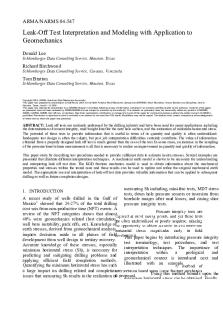
Leak-off test geomechanics
- 13 Pages
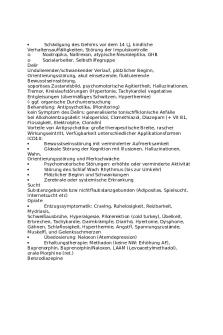
Test - test
- 1 Pages
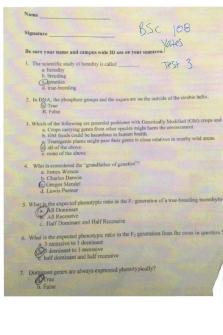
Yates Test 3 - Test
- 7 Pages
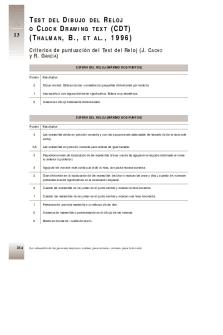
Test-reloj - test
- 4 Pages
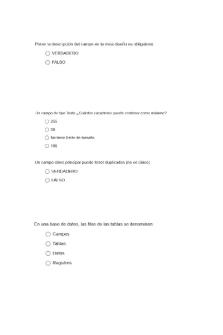
Test Access 2010 - Test
- 6 Pages
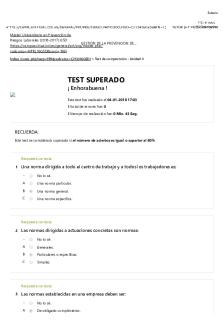
Resultado Test 842 - TEST
- 2 Pages
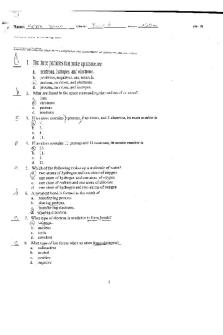
AP. Bio. Test - test
- 4 Pages
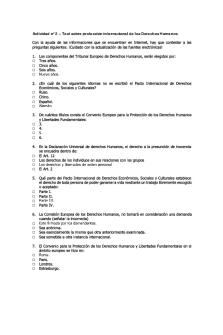
Test
- 4 Pages
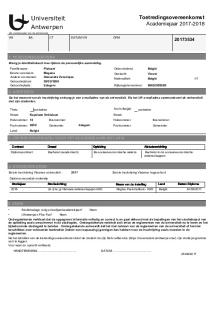
TEST
- 1 Pages

Chapter 4-test - test
- 23 Pages
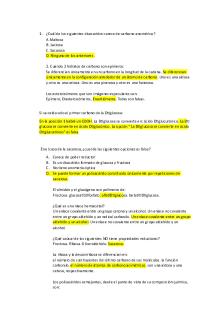
Test preguntas - test
- 4 Pages
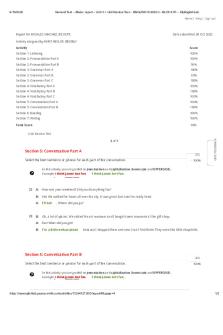
Test 3 - 5 - test
- 2 Pages

PET TEST Full Test
- 35 Pages

Preguntas TEST - CG - Test
- 4 Pages
Popular Institutions
- Tinajero National High School - Annex
- Politeknik Caltex Riau
- Yokohama City University
- SGT University
- University of Al-Qadisiyah
- Divine Word College of Vigan
- Techniek College Rotterdam
- Universidade de Santiago
- Universiti Teknologi MARA Cawangan Johor Kampus Pasir Gudang
- Poltekkes Kemenkes Yogyakarta
- Baguio City National High School
- Colegio san marcos
- preparatoria uno
- Centro de Bachillerato Tecnológico Industrial y de Servicios No. 107
- Dalian Maritime University
- Quang Trung Secondary School
- Colegio Tecnológico en Informática
- Corporación Regional de Educación Superior
- Grupo CEDVA
- Dar Al Uloom University
- Centro de Estudios Preuniversitarios de la Universidad Nacional de Ingeniería
- 上智大学
- Aakash International School, Nuna Majara
- San Felipe Neri Catholic School
- Kang Chiao International School - New Taipei City
- Misamis Occidental National High School
- Institución Educativa Escuela Normal Juan Ladrilleros
- Kolehiyo ng Pantukan
- Batanes State College
- Instituto Continental
- Sekolah Menengah Kejuruan Kesehatan Kaltara (Tarakan)
- Colegio de La Inmaculada Concepcion - Cebu

